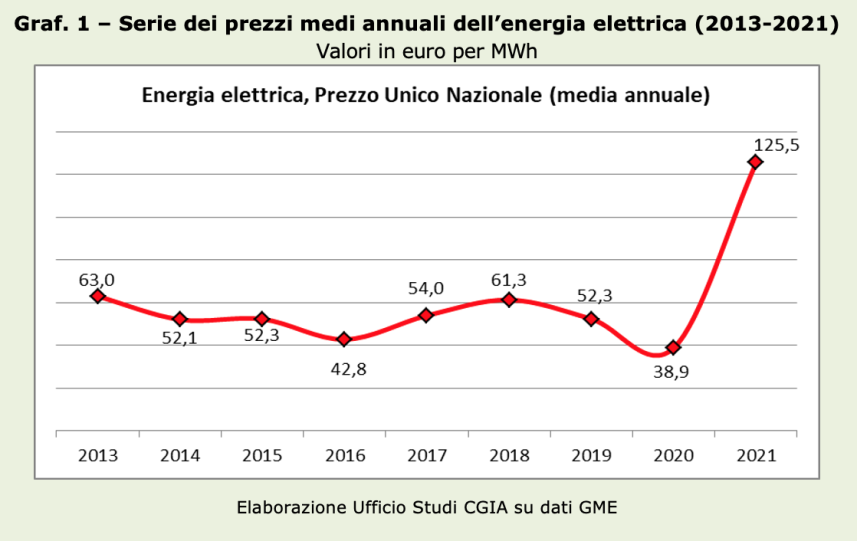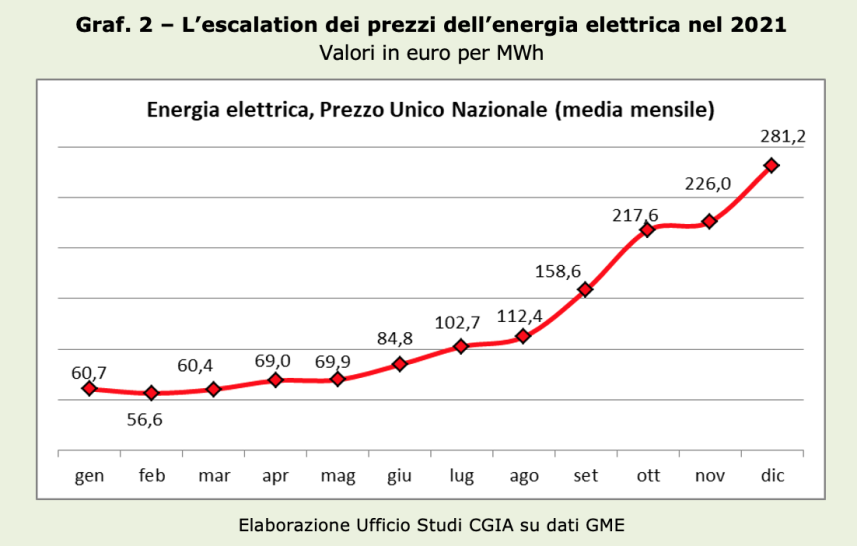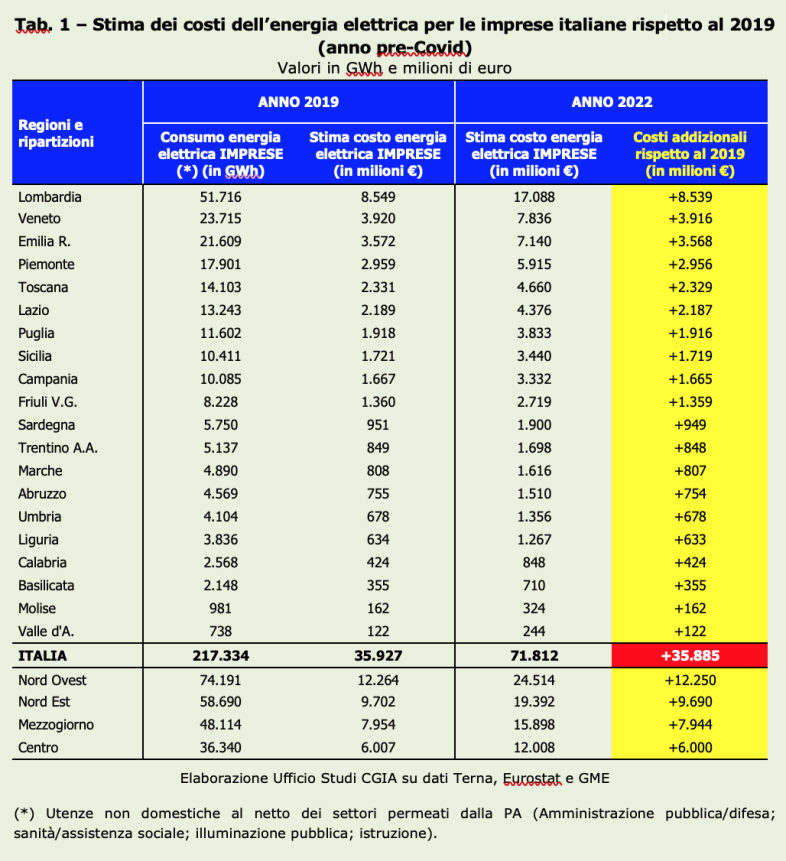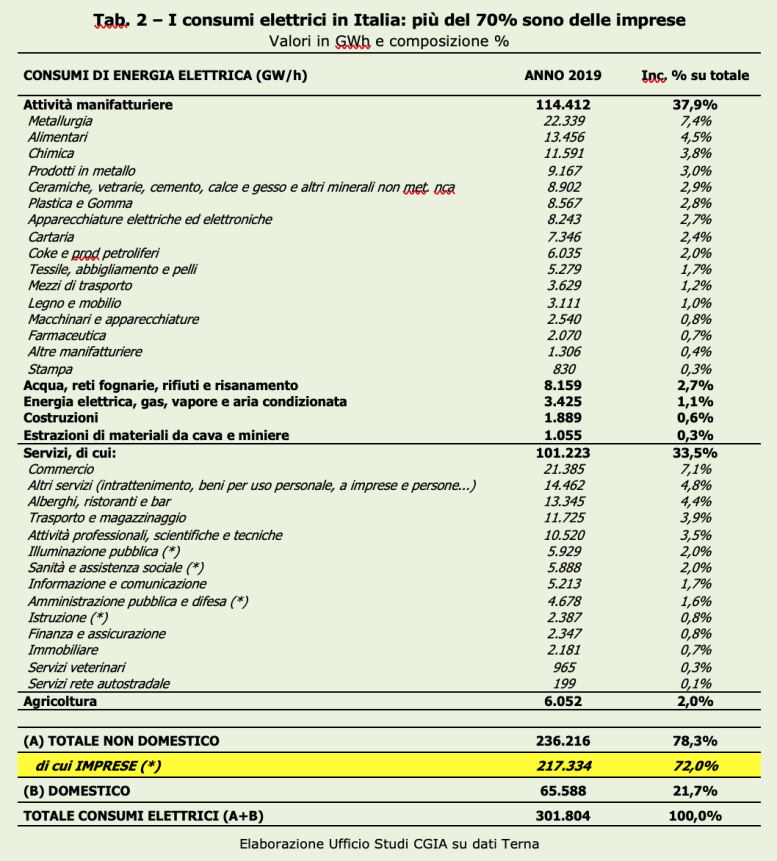Compared to 2019, the extra cost that Italian companies will incur this year due to the increase in the price of electricity tariffs amounts to almost 36 billion euros. In fact, within 3 years, the cost of electricity bills for companies has almost doubled. A frightening increase which, added to the increase in gas prices, will force many businesses, at least temporarily, to close their production plants.
The calculations were carried out by the CGIA Studies Office which, for the current year, assumed an overall consumption of electricity by the companies equal to that recorded in 2019 (pre-Covid year). In addition, an average electricity tariff for businesses of € 2022 per MWh has been estimated for 150. This threshold was determined since in the first 5 days of this new year the tariff fell below 200 euros per MWh. It should also be noted that the main institutions expect a gradual (although not very fast) reduction throughout 2022. Finally, it should be remembered that last December the average price of electricity for companies had reached € 281 per MWh (2021 average equal to € 125,5 per MWh).


At the territorial level, the higher price increases will affect companies located in Lombardy: compared to 2019, the increase in the cost of electricity will be equal to 8,5 billion euros. Immediately after we see the Veneto with an extra cost of 3,9 billion euros, Emilia Romagna with 3,5 billion and immediately after Piedmont with 2,9 billion euros. Since economic activities are concentrated mainly in the North, the activities of this division will suffer the overall amount of the most important increases. Against an increase that, as we said, will be almost 36 billion at the national level, 22 (equal to 61 per cent of the national total) will affect northern companies.

The most “affected” sectors will be, at least theoretically, those that record the most important electricity consumption. Referring to the electricity consumption data for 2019, they are:
• metallurgy (steel mills, foundries, ironworks, etc.);
• trade (shops, shops, shopping centers, etc.);
• other services (cinemas, theaters, discos, laundries, hairdressers, beauticians, etc.);
• food (pasta factories, ham factories, bakeries, mills, etc.);
• hotels, bars and restaurants;
• transport and logistics;
• chemistry.

To deal with this situation, according to the CGIA, a common European strategy must be implemented in the medium term to stabilize the price of gas on the market, standardizing the supply conditions and thus reducing the price differentials between member countries. Hoping that this blaze will end by the first part of 2022, the situation must be addressed immediately with urgent measures. According to the CGIA Studies Office, in fact, the Government should increase the resources already made available with the 2022 Budget Law, making at least € 1 billion per month available to companies until next June to calm tariff increases. .
Methodological note
The estimates were built starting from the data on energy consumption of companies in 2019 (the year before Covid), assuming for the current year (2022) the same consumption as in 2019.
The estimate of the electricity bill for companies in 2019 (equal to 36 billion euros net of VAT) is the result of a calculation that takes into account the weighted average prices by class of energy consumption obtained from the Eurostat database for users non-domestic on a half-yearly basis.
The estimate of electricity costs relating to 2022 was constructed assuming, for 2022, an average Single National Price (PUN) equal to 150 euros per MWh; the PUN is the reference price of electricity recorded on the Italian Power Exchange and is monitored by the statistics of the GME (Gestore dei Mercati Elettrici); in this estimate, such an increase compared to 2019 (+ 187% for the PUN which in the pre-Covid year stood at 52 euros per MWh), translates into a "slightly" lower percentage growth in the electricity bill of companies which in any case would double (+ 100%) reaching 72 billion euros as the increase in the price of the raw material impacts on part and not on the entire cost of the bill (which also includes marketing, transmission, charges, margins etc.).
The forecast of an average price of 150 euros per MWh for 2022 is higher than the average price of 2021 (125 euros per MWh), a year that was however characterized by the flare-up of prices in the last quarter with values that broke through abundantly 200 euros per MWh; even 281 euros per MWh in December 2021.
In this work an average price of 150 euros per MWh was chosen since in the first days of January 2022 the price fell below 200 euros per MWh and that the main institutions foresee a progressive (although not very fast) price reduction during 2022. However, in the adverse hypothesis of an average price of 200 euros per MWh in 2022, the impact on businesses would be even more dramatic with an electricity bill that would exceed 90 billion euros (+ 150% compared to 2019).